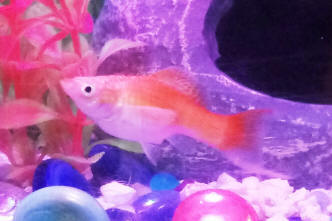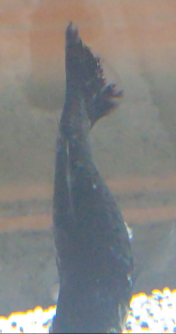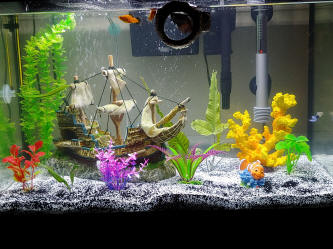FAQs on the Molly Health/Disease
11
Related Articles: Mollies, &
Poeciliids: Guppies, Platies,
Swordtails, Mollies by Neale Monks,
Livebearing Fishes by Bob
Fenner,
FAQs on Molly Disease:
Molly Disease 1,
Molly Disease 2,
Molly Disease 3,
Molly Disease 4,
Molly Disease 5,
Molly Health 6,
Molly Health 7,
Molly Health 8,
Molly Health 9,
Molly Health 10,
FAQs on Molly Disease by Category:
Nutritional (e.g. HLLE),
Social, Infectious (Virus, Bacterial, Fungal),
Parasitic (Ich, Velvet...),
Genetic, Treatments
FAQs on Molly Reproduction/Breeding:
Molly Reproduction
1, Molly Reproduction 2,
Molly Reproduction 3,
|
|
|
Molly in labor 5 days and counting!! She's exhausted!! Help!!
4/15/20
Hi, Elizabeth from Tulsa, Oklahoma. I have a prego molly stuck in labor day
5. She is so exhausted she falls asleep on the floor of the nursery tank and
looks dead. So dead i almost netted her out, actually had her out of the
water before she started flopping. When she contracts she has what looks to
be 2 tails hanging out of her. What can i do?
<Sadly, not much. Epsom Salt, at a dosage of 1-3 teaspoons per 5 gallons/20
litres, can have a useful laxative effect on fish. Since we're dealing with
smooth muscle here (there's no pelvic girdle in fish, so the birth canal
doesn't go through any openings between bones) laxatives can be useful.
Beyond that, there's no real way to manipulate the fish without significant
risk of damaging the Molly. Pulling at the tails of the fry, for example,
runs the risk of tearing tissues within the mother, which quickly become
infected. Pressing on the belly of the female, to push the fry out, could
easily burst internal organs, again, leading to death. On the plus side,
what you are experiencing here happens only very, very rarely with
livebearers, but alas, it does happen -- and I lost a beautiful big female
Halfbeak from exactly this. The fry had died, decomposed, and ultimately
expanded out through the birth canal as time passed, infecting the mother
and causing her death. Good luck, Neale.>
|
 |
Help with black mollies 11/11/18
I have 2 black mollies I think one male one female one of them the
skinnier one will sit at the bottom take a little bit and then held swim
up and swim next to the other one and he let himself float down to the
bottom of chain sit there for a little while and the other one is way
bigger than the other ones skinny ones having the problem or if it is a
problem I don't know but I'm just wondering if it's normal behavior or
if it's something I should be concerned about
<Hello Mike. Let me have you do some reading first:
http://www.wetwebmedia.com/fwsubwebindex/mollies.htm
The thing about Mollies is that they're a bit disease prone when kept in
plain freshwater. Certainly, hard water is better, and ideally, a
reasonable amount of salt, maybe 2-3 teaspoons per US gallon, can make
all the difference. On top of that, they're often maintained poorly by
retailers and wholesalers, and the quality of farmed Mollies is very
variable. So it's a bit hit-and-miss whether you get healthy ones or
not.
Understanding their specific needs will help a lot. So yes, I'd be
worried about a skinny Molly that wasn't swimming properly, but before
medicating, I'd be checking water chemistry first. Simply maintaining
them in saline conditions can make all the difference! Cheers, Neale.>
|
Mollie needs help PLEASE? Beh., stkg.
10/29/18
So I've had my Dalmatian since May. My favorite of all. My male black
Mollie CONSTANTLY harasses her since June.
<Mmm; yes; this is "what they do"; hence the need for stocking more
females than males, having decor they can hide, evade each other, space
to get away>
She just had fry last week. Since her spine is all bent and keeps
swimming weird. I moved her to my other tank (no males just a community
Betta and a couple guppies) but is she sick or is this normal?
<Likely normal>
Took black stallion months to even get her pregnant of constant
harassment. I don't want to lose her. I can send pic or video if that
would help. Thanks in advance.
<Add more females if you have room; more floating plants... perhaps
watersprite/Ceratopteris. Bob Fenner>
Mollie needs help PLEASE? /Neale
11/1/18
So I've had my Dalmatian since May. My favorite of all. My male black
Mollie CONSTANTLY harasses her since June.
<It is what the males do. Ideally, keep 2-3 females per male, and even
better if you can add some salt-tolerant floating plants to help her
hide at times, such as Floating Indian Fern.>
She just had fry last week. Since her spine is all bent and keeps
swimming weird. I moved her to my other tank (no males just a community
Betta and a couple guppies) but is she sick or is this normal?
<Not normal.>
Took black stallion months to even get her pregnant of constant
harassment.
<It's very unusual for female Mollies (kept with males) to *not* be
pregnant, and much more likely that any fry were eaten by other fish
before you see them. But yes, harassment can cause them to miscarry on
occasion.
See above with regard to tips that can help.>
I don't want to lose her.
<Do review the basics.
http://www.wetwebmedia.com/fwsubwebindex/mollies.htm
Mollies appreciate warmth, hard water, a plant-based diet, and a bit of
salt added to the water. In fact they'll thrive in seawater, but often
become sickly in plain freshwater, and adding a scant teaspoon (around 5
grams) of aquarium 'tonic' salt or even better marine salt mix per litre
of water can make a huge difference. That's about two-thirds of an ounce
per US gallon.>
I can send pic or video if that would help. Thanks in advance.
<Hope this helps, Neale.>
|

 |
|
Re: Mollie needs help PLEASE?
11/1/18
My aquariums are in excellent status to suit Mollies and all levels of nitrites,
nitrates, ammonia, pH are all great
<Actual values would mean a lot more to me than this statement, I'm afraid.
What's "excellent" for Bettas is actually "terrible" for Mollies. So it's one,
or the other, but can't be both. Kind of like saying you're keeping both Camels
and Polar Bears in the same excellent environment. Can't possibly be true. Make
sense?><<Does to me; excellent allusion/comparison. B>>
and have been for months and there are a total of 5 females (1 Dalmatian and 4
white) to one male (black). I always use aquarium salt when cleaning and
pre-prepping new water.
<How much? Depending on the hardness and pH of your tap water, more or less salt
would be helpful. If you have very hard, alkaline water -- i.e., around 20
degrees dH, pH 8 -- then you might not need much salt at all. But if you had
soft water -- <10 degrees dH, <pH 7 -- then a sizeable quantity of salt would be
essential for Mollies to survive any great length of time.>
I never just add tap water.
<Good.>
Tanks always crystal clear. Seems like she gave birth and then ended up like
this the next morning and hasn't changed since. She is the only one having an
issue I see that way however I noticed the top dorsal fin on Midnight (black
Mollie) and Pearl (2 of the white ones) brown tint spots rather than his black
and her white and I used my lens to zoom in and almost looks as if my bristle
nose looks to be almost beginning to peel. Maybe too much salt?
<For the Mollies, no; for the other fish, could easily be. Salt SHOULD NOT be
used in standard community tanks except for treating specific illnesses. Put
another way, a "safe" level of salt for Bettas and Bristlenose Catfish will have
no, as in ZERO, helpful effect on your Mollies. The idea of using "tonic salt"
in community tanks goes back decades, and some aquarium shops still sell the
stuff, even though it's been debunked since at least the 1980s.>
I even have a community Betta and all seem happy but the Dalmatian (Spinky).
<Do please read the article I sent you last time. Mollies are NOT community
fish, and attempts to keep them thus usually have mixed results, at best. Some
live, some die, but hardly anyone gets all the Mollies they bought to live long,
normal lives in plain vanilla community tanks.>
I test my water after every cleaning, liquid test kit not strips,
<So again, please share the values, not your interpretations.>
and I never do the filter on the same day
<Good.>
I usually give 2 days between cleaning tank and cleaning filter.
<I'd even leave a week, but sure, this is fine.>
I have noticed a wee hint of stinky fish odor.
<Often normal. Could be decaying fish food around the hood/edges of the tank.>
But I was able to capture 12 of her babies in a breeder net.
<Cool.>
Thx for any and all other advice. Maybe the only thing different I've done
recently was add drift wood and feeding zucchini to my albino algae eaters and
Bristlenose buddy and my zebra algae eaters in my other tank but the other tank
seems fine. I did soak the drift wood (purchased at an actual fish store not
just a pet store) for about 7 days plus boiled prior and let cool before adding.
Thanks in advance.
<The Molly with the white gunk is showing the classic 'something wrong, but hard
to say what' scenario you see with livebearers generally. It may be a parasite
called Costia (also known as Slime Disease) but often seems to be environmental.
High nitrate can be a cause, especially with Mollies, which in freshwater rarely
tolerate above 20 mg/l nitrate before showing a tendency towards disease. Read,
review your tank, and act accordingly.
Cheers, Neale.>
Re: Mollie needs help PLEASE? 11/1/18
Okay, thank you. Nitrates 0 ppm,
<I find that hard to believe unless you have rampant plant growth (i.e.,
removing armfuls of plants per week) and minimal stocking. Nitrate is the end
product of the biological filtration process. It goes nowhere. So should
accumulate between water changes. If it doesn't increase above tap water levels,
then either there's no biological filtration going on, or your test kit is
broken. Tap water supplies typically have somewhere between 10-40 mg/l,
depending on your supplier, so again, zero levels even for freshly drawn tap
water are extremely unusual.>
Nitrites 0 ppm, ammonia 0 ppm,
<Fine.>
pH around 7.6-7.8 if that helps.
<Good for Mollies; less good for Bettas and Bristlenose Cats. You don't mention
how much salt you add. Likely adding more (which would stress/kill the Betta)
would be a very good first step in the sick Molly's recovery.>
Both tanks. My tank with the Betta she is solely with guppies and mollies are in
their own tank.
<Understood. Regardless, Bettas and Mollies aren't really compatible for the
reasons described earlier. Mollies are best kept with Mollies, Mollies, or some
other type of Molly. Being slightly flippant there, but their need for
relatively warm water, brisk water currents, plant-based diet, hard water
chemistry, and realistically, the option to add significant salinity, all make
them tricky to house with anything other than fish from similar habitats. Some
coastal Killifish species can work, like Florida Flags, and some of the gobies
too, Knight Gobies for example, but otherwise Mollies are single-species rather
than community tank residents if you want 100% success.>
Thanks again.
<Most welcome. Cheers, Neale.>
Re: Mollie needs help PLEASE?
11/3/18
Well thanks for the education on mollies.
<We aim to please!>
Nitrites are at about the 30 mark
<Do you mean nitrate? Nitrite (with an "i") would be beyond lethal at 30 mg/l.
Nitrate (with an "a") at 30 mg/l would be typical tap water, a bit high for
Mollies (in freshwater, at least) and most cichlids as well, but acceptable to
most other community fish (tetras, catfish, etc.). So fine for general
fishkeeping, but not good for Mollies if you insist on keeping them in
freshwater conditions.>
but I test after 48 hours of water change so water has time to cycle through
biofilter.
<Nitrate will ONLY increase going through a biological filter. By definition
that has to be the case, since what a biological filter does is turn toxic
ammonia ions into less toxic nitrite ions, and then those less
toxic nitrite ions into almost completely harmless nitrate ions. Nitrate is the
end product, so kind of like dirty plates in a restaurant without a dishwasher,
as time passes, just as the pile of dirty plates gets taller,
so does the nitrate level in the fish tank go up. Nitrate is, in almost all
community tanks, removed (well, diluted at least) through water changes. If your
nitrate level is 30 mg/l out of the tap, then that's as low as it can ever go.
It'll creep up to 35, 40, 45 mg/l as the weeks pass. Under experimental
conditions, nitrate isn't particularly toxic until at least upwards of 100 mg/l,
but that's based on work with food fish done in labs.
Some aquarium fish are equally tolerant, but cichlids, Mollies, and most marine
fish are much more sensitive. They become sickly as nitrate creeps above 20
mg/l, and above 40 mg/l they often show severe health problems. In the case of
Mollies, it's often over-production of mucous that becomes the most obvious
thing, together with fin-clamping, rocking from side to side ("the shimmies"),
and a tendency towards diseases such as Finrot and Fungus.>
I also use stress zyme plus when needed.
<Let's be clear here. API Stress Coat is a useful product for use when shipping
fish or when introducing new livestock that may have been damaged in transit,
but otherwise serves no particular benefit above that of plain vanilla water
conditioner. So it's nice, but not essential. API Stress Zyme on the other hand
is almost completely useless. It may or may not speed up the cycling process,
reports are very mixed indeed, but what it doesn't do is magically improve the
aquarium once the filter is properly matured. Of
course API will happily sell the stuff, and it probably does no harm, but it
doesn't do anything a water change and filter clean won't do better.>
Bettas water is diff than the Molly tank.
<Good oh!>
Thx again. Going to redo something's. And I do have plants in the tanks.
Have a great day and again thx for your time.
<Glad to help. Neale.>
|
|
|

